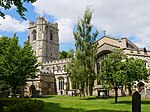Luton Bute Street railway station
1858 establishments in England1965 disestablishments in EnglandBeeching closures in EnglandBuildings and structures in LutonDisused railway stations in Bedfordshire ... and 7 more
East of England railway station stubsFormer Great Northern Railway stationsPages with no open date in Infobox stationRailway stations in Great Britain closed in 1965Railway stations in Great Britain opened in 1858Transport in Luton/Dunstable Urban AreaUse British English from November 2017

Luton Bute Street railway station was the first to be built in Luton, England. It was opened by the Luton, Dunstable and Welwyn Junction Railway Company in 1858, which was an extension of the Welwyn and Hertford Railway. The track to Welwyn was completed in 1860 and taken over by the Great Northern the following year.
Excerpt from the Wikipedia article Luton Bute Street railway station (License: CC BY-SA 3.0, Authors, Images).Luton Bute Street railway station
Bute Street,
Geographical coordinates (GPS) Address Nearby Places Show on map
Geographical coordinates (GPS)
| Latitude | Longitude |
|---|---|
| N 51.8817 ° | E -0.4139 ° |
Address
Bute Street Shoppers Car Park
Bute Street
LU1 2EY , High Town
England, United Kingdom
Open on Google Maps








